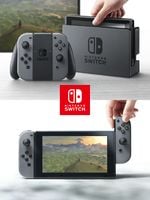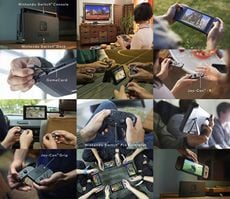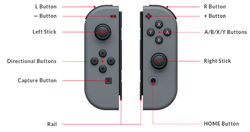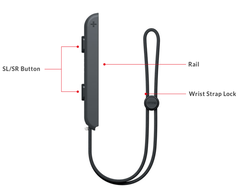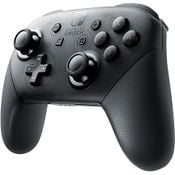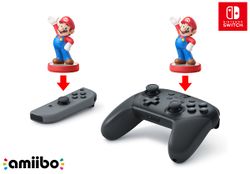Nintendo Switch
This article is about an upcoming console. Editors must cite sources for all contributions to this article. Edits that do not follow this standard may be reverted without notice.
The Nintendo Switch (codenamed the NX in development)[1] is Nintendo's upcoming hybrid video game console and its seventh major home game console. Despite this classification, Nintendo markets the system mostly as a home console rather than a portable handheld system.[2][3] It was officially announced on October 20, 2016,[4] and is set to be released simultaneously on March 3, 2017 in Japan, the US, Canada, Europe, Hong Kong, and other territories.[5] It will cost US $299.99 in America, and JP ¥29,980 in Japan.[5] A Nintendo Switch presentation containing more information about the system was live-streamed from January 12, 2017 at 11:00 PM to January 13, 2017 at 12:05 AM (EST).[6][5] The Nintendo Switch is set for a hands-on event on six separate Sundays in six different cities across America prior to its release date,[5][7] along with Tokyo Big Sight, Japan.[5] Pre-order retail reservations have started on January 21, 2017 in Japan.[5] As of January 12, 2017, 50 companies have collaborated with Nintendo and 80 games are currently in development for the Nintendo Switch.[5]
Features
The Nintendo Switch is an LCD tablet-like console that is designed to be a hybrid between home and handheld systems, though it is primarily referred to as a home console. The Switch can be played in three different styles; TV Mode, Tabletop Mode, and Handheld Mode.[5] In "TV Mode", the system is plugged into a "Nintendo Switch Dock". [8] With the system docked, gameplay footage will be displayed on the TV screen. With the console detached, the footage will be displayed on the console's screen. When using "Tabletop Mode", the consoles uses a built-in kickstand to prop the system up. When in "Handheld Mode", the two "Joy-Con" controller pods are attached to the sides of the console, giving it a similar design to the Wii U's GamePad. The Joy-Con can also be removed and used either as separate controllers, similar to small NES and SNES controllers, used as one controller together, or optionally docked into the "Joy-Con Grip"[8] to give a more traditional experience.
The Nintendo Switch console will use "Game Card" cartridges, similar to the Nintendo DS line, making it the first Nintendo home console since the Nintendo 64 to use game cartridges. The Nintendo Switch Dock also has two USB 2.0 ports,[9] an HDMI output,[5] an AC adapter port, and a TV output LED light.[9] The Nintendo Switch has built in Wi-Fi,[5] Bluetooth 4.1 connectivity,[10] a multi-touch capacitive touchscreen of 6.2-inch diagonally,[5] a resolution of 1920 x 1080p on TV Mode and 1280 x 720p on Tabletop or Handheld mode,[10] a USB Type-C connector,[5] internal memory of 32 GB,[10] a microSD slot (upgradable with microSDHC/SDXC cards),[10] a 3.5mm headphone jack, a brightness sensor, two speakers in the bottom, and a battery life ranging anywhere between 2.5-6.5 hours.[5][10] For example, battery life during The Legend of Zelda: Breath of the Wild gameplay is 3 hours.[9]
Players can also link up to 8 multiple consoles to play against each other via local multiplayer.[5] Each Joy-Con can be used for 2 player co-op, dubbed by Nintendo as "sharing the joy".[5]
Peripherals
Joy-Con
The two Joy-Con have an accelerometer and gyro sensor.[5] The Joy-Con (R) has an IR motion camera that can sense and measure the real-time shape, motion, and distance of objects.[5] Two SL and SR shoulder buttons are on each Joy-Con.[5] The Joy-Con can be slid into the Joy-Con Grip on the controllers' rails.[5] The Joy-Con will launch with two color sets: the standard gray and neon blue and neon red.[5] Much like the Wii Remote, each Joy-Con has gray wrist straps with slide locks,[5] with other colors sold separately.[5] An HD rumble feature for high definition motion controls is included in the Joy-Cons, which can convey realistic sound effects from the Joy-Con speakers based on motion controls. For example, shaking the Joy-Con can give the illusion of ice cubes being shaken within a glass cup, which can be heard via the Joy-Con speakers.[5] Both Joy-Con have Bluetooth 3.0 connectivity.[11] The Joy-Con have a battery life of up to 20 hours and a charging time of 3.5 hours.[11] The Joy-Con (L) has a capture button that can take a screenshot of gameplay, which can be saved onto the system's Album, and can later be uploaded to social media. It has also been discussed that an update in the near future will add the capacity to record real time gameplay, and allow that to be uploaded to social media.[5] Two games are currently set to release that utilize the Joy-Con HD rumble features, such as a minigame-based game called 1-2 Switch set to release as a launch title and a wrestling game called ARMS in Spring 2017.[5]
Buttons




- SL
- SR
- Release buttons
- Sync buttons
- Volume buttons (- and +)
- Directional buttons
- Capture button
- Left analog stick
- Left analog stick button
- Right analog stick
- Right analog stick button
(Home)
- Power
Nintendo Switch Pro Controller
A traditional controller, simply called the Nintendo Switch Pro Controller,[8] will also have a D-pad, replacing one set of the directional buttons on the Joy-Con (L). The Pro Controller features the same set-up as the Nintendo GameCube Controller, with the second analog stick set below the face buttons. The Nintendo Switch Pro Controller has a battery life of up to 40 hours and charging time of 6 hours,[12] includes an NFC sensor for scanning and writing amiibo figures, and is sold separately.[5]
amiibo
- Main article: amiibo
Several Mario series amiibo were shown in the initial reveal trailer, and it was later confirmed that the Nintendo Switch will have amiibo support.[13] The Joy-Con (R) and Nintendo Switch Pro Controller both have an NFC sensor for scanning and writing amiibo figures.[5][14]
Software
The Nintendo Switch will be able to synchronize with smartphones via an application; this allows for online capability for inviting friends to play online, set play appointments, and voice chat with friends on online matches.[5] The Nintendo Switch will not have region locking, similar to Nintendo handhelds prior to the Nintendo DSi.[5] A Nintendo Account is necessary to access any online features, with a free trial period for its online service at launch and will later start charging JP ¥2,000-¥3,000 in Japan and US $17.50-$26.50 in America annually starting Fall 2017.[5][15][16] Software for Nintendo Switch will be available to purchase at retail, and possibly from Nintendo eShop as well. The Nintendo Switch is the first Nintendo home console since the Nintendo 64 to have retail software stored on cartridges rather than discs.
Nintendo Switch Parental Controls
The Nintendo Switch will also use optional parental controls, being controlled from a smartphone via an application named "Nintendo Switch Parental Controls", in order to control and monitor a minor's playing time. Nintendo has released a video featuring Bowser and Bowser Jr. detailing the functions of the application, with the former monitoring the latter's playing of Mario Kart 8 Deluxe. Boos also appear in the video and Bowser is shown to have a picture of Princess Peach as his phone wallpaper.[17][18]
Nintendo eShop
- Main article: Nintendo eShop
The Nintendo eShop is confirmed to make a return, during a small footage depicting the Nintendo Switch's system menu, which will be available after a system update.[5][19]
Nintendo Switch HOME Menu

At the top of the Nintendo Switch's system menu, referred to as the HOME Menu by Nintendo Europe,[20] there are profile icon(s), time display, Wi-Fi/airplane mode status display, and battery display. The middle portion includes grids for displaying games' icons, and the bottom has icons for applets including News, Nintendo eShop, Album, Controllers, System Settings, and Sleep Mode, along with a controller display in the lower left.[5]
Physical and digital games
Gallery
System
Software
- SMO Logo - NA.png
PAX South Event
External links
References
- ^ Iwata, Satoru (March 17, 2015) Business and Capital Alliance Announcement. Nintendo. Retrieved January 31, 2016
"[...] let me confirm that Nintendo is currently developing a dedicated game platform with a brand-new concept under the development codename 'NX'." - ^ Reggie calls the Nintendo NX a home console. Wii U Daily (June 19, 2015). Retrieved June 16, 2016.
- ^ PR - First Glimpse of Nintendo NX Coming Tomorrow at 7 a.m. PT. GoNintendo (October 19, 2016). Retrieved October 19, 2016.
- ^ Nintendo. (October 20, 2016). First Look at Nintendo Switch. YouTube. Retrieved October 20, 2016.
- ^ a b c d e f g h i j k l m n o p q r s t u v w x y z aa ab ac ad ae af Nintendo (January 12, 2017) Nintendo Switch Presentation 2017 YouTube. Retrieved February 11, 2017.
- ^ Nintendo of America. (October 26, 2016) https://twitter.com/NintendoAmerica/status/791455799302246400. Twitter. Retrieved November 11, 2016.
- ^ http://www.nintendo.com/switch/events/
- ^ a b c http://www.nintendo.com/whatsnew/detail/first-look-at-nintendos-new-home-gaming-system
- ^ a b c Nintendo. Nintendo Switch Features Nintendo. Retrieved February 11, 2017.
- ^ a b c d e Nintendo. Nintendo Switch Specs (Japanese). Nintendo. Retrieved February 11, 2017.
- ^ a b Nintendo. Nintendo Switch Joy-Con Specs (Japanese) Nintendo. Retrieved February 11, 2017.
- ^ https://www.nintendo.co.jp/hardware/switch/accessories/index.html
- ^ http://nintendoeverything.com/nintendo-confirms-amiibo-support-for-switch-says-dock-is-for-tv-output-and-charging
- ^ https://www.facebook.com/amiiboUK/photos/a.336211199898791.1073741828.336093763243868/611534995699742/?type=3&theater
- ^ http://www.nintendo.com/switch/online-service/
- ^ https://twitter.com/serkantoto/status/826841955111890944
- ^ https://www.youtube.com/watch?v=03bAayBtcb0
- ^ http://www.nintendo.com/switch/family-fun/
- ^ https://www.youtube.com/watch?v=t5lK0yzP6_4&t=88
- ^ https://www.nintendo.co.uk/Nintendo-Switch/Specifications/Specifications-1176277.html
